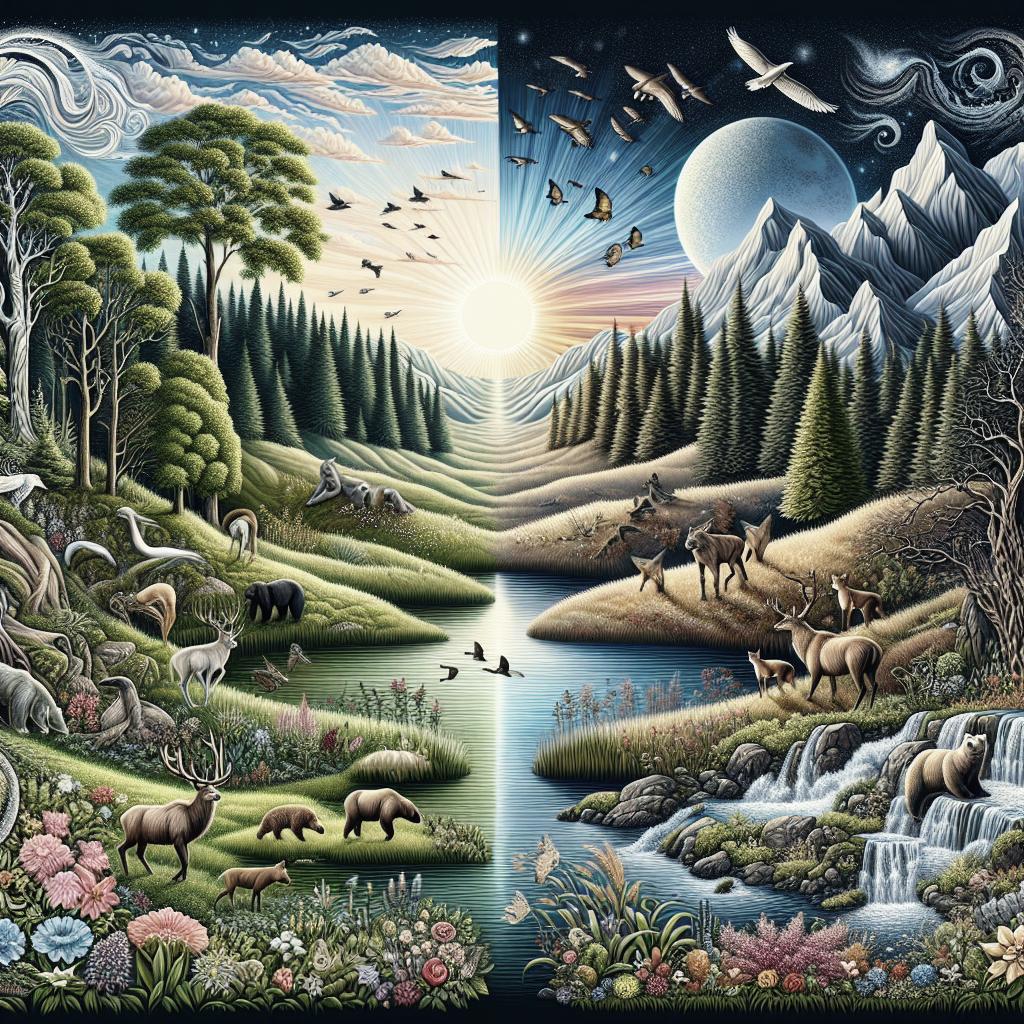Exploring the beauty of nature through poetry is an enriching way to connect with the world around us. Poets have long used natural imagery to evoke emotion, introspection, and a sense of connection to the wider universe. This blog post delves into six classic poems that bring us closer to nature, each offering unique insights into its beauty and complexity. From Frost’s contemplation of choice in a wooded setting to Blake’s vivid portrayal of the “Tyger,” these works traverse the spectrum of thoughts and feelings nature inspires. Additionally, you will find recommendations for further reading and exploration, whether you’re longing for a captivating family adventure in Acadia National Park or seeking to discover quieter paths less traveled. Now, let’s immerse ourselves in these poetic landscapes and uncover the timeless allure of nature in verse. ### What poems bring you closer to nature? Here are six of my favourites. Poetry has a remarkable capacity to transport us to different places, sometimes real and other times imaginary. Nature has been a prominent theme throughout the ages, and these six poems specifically stand out for their vivid imagery and emotional depth. They draw us into lush forests, onto tranquil waters, and through picturesque landscapes, highlighting the beauty of our natural world. By examining each poem, we gain a deeper appreciation for nature and how it inspires the human spirit. ### “The Road Not Taken” by Robert Frost Robert Frost’s “The Road Not Taken” is a reflection on choices and the paths we take in life. The poem opens in a “yellow wood” and unfolds through natural imagery that symbolizes the decisions we face. Frost uses the metaphor of diverging roads to explore the idea of life’s journey, inviting readers to consider how we choose our paths and the impact of those choices on our future. The beauty of this poem lies not only in its vivid depiction of a forest pathway but also in its introspective nature. Frost paints a picture of a serene natural setting, inviting readers to pause and reflect on the decisions they’ve made. The poem evokes a sense of tranquility and introspection that can only be found in nature, making it a timeless piece of literature that continues to resonate with readers. ### “Tulips” by Sylvia Plath Sylvia Plath’s “Tulips” offers a contrasting view of nature’s beauty, focusing on the stark red tulips that contrast with the sterile whiteness of a hospital room. This juxtaposition enhances the vibrancy of the flowers, making them a powerful symbol of life and vitality. Plath’s rich imagery paints a detailed picture that allows readers to feel the intensity of the tulips’ colors and the life they represent. The poem delves into themes of renewal and healing, using nature as a metaphor for the emotional shifts experienced during personal transformation. The tulips’ beauty becomes a force of nature that disrupts the speaker’s initial sense of numbness. Through the poem, Plath demonstrates nature’s ability to evoke powerful emotions and symbolize hope and endurance, even in challenging circumstances. ### “Sonnet 18” by William Shakespeare William Shakespeare’s “Sonnet 18” is one of the most celebrated poems in the English language, often remembered for its famous opening line: “Shall I compare thee to a summer’s day?” This sonnet explores the timeless beauty of nature by comparing it to a beloved person, suggesting that true beauty can withstand the ravages of time. Shakespeare’s use of natural imagery highlights the ephemeral nature of seasons and the enduring quality of beauty captured in verse. By likening his subject to the unwavering constancy of a summer day, Shakespeare underscores the idea that art and nature possess an eternal grace that remains unblemished by the passage of time. The poem’s mention of the sun, winds, and changing seasons serves as a reminder of nature’s perpetual cycles, providing a gateway to deeper reflections on life and love. ### “The Tyger” by William Blake William Blake’s “The Tyger” is renowned for its vivid and striking imagery that conjures the formidable beauty of nature. The poem poses rhetorical questions about the creation of the fearsome beast, prompting readers to ponder the duality of nature’s fierceness and beauty. Blake marvels at the intricacies found in the tiger’s design, raising questions about divine craftsmanship. Through intense, rhythmic language and powerful imagery, Blake captures the tiger’s might and mystique, illustrating nature’s complex and awe-inspiring elements. This poem encourages readers to examine the balance between creation and destruction, beauty and terror, often found within natural phenomena. The beguiling blend of these elements makes it a timeless piece that resonates with the complexities of existence. ### “Time does not bring relief; you all have lied” by Edna St. Vincent Millay Edna St. Vincent Millay’s poem, “Time does not bring relief; you all have lied,” offers a poignant perspective on nature, focusing on its role in processing grief and loss. While nature is often associated with healing and solace, Millay challenges this notion by expressing a longing that time cannot mend. Her use of natural imagery evokes a sense of perpetual beauty that contrasts with the speaker’s emotional turmoil. Millay’s poem invites readers to grapple with the harsh realities of time and memory, acknowledging that pain sometimes endures regardless of the surrounding natural beauty. The acknowledgment of this internal struggle against a backdrop of serene landscapes ensures the poem resonates deeply with those who find themselves wrestling with unresolved sorrow. It serves as a reminder that nature’s beauty can sometimes intensify rather than soothe our inner conflicts. ### “I Wandered Lonely as a Cloud” by William Wordsworth William Wordsworth’s “I Wandered Lonely as a Cloud” is a quintessential Romantic poem that celebrates the tranquility and joy found in nature. Wordsworth describes an encounter with a “host of golden daffodils” that seem to dance in the breeze, capturing a moment that imprints upon his memory and offers solace in times of solitude. This poem exemplifies Wordsworth’s belief in nature’s power to inspire and uplift the human spirit. The imagery of the dancing daffodils evokes a sense of harmony and peacefulness, illustrating how nature can serve as a source of comfort and reflection. Wordsworth’s vivid descriptions and emotional resonance create a timeless appreciation for the simple pleasures and profound beauty found in the natural world. ### More Articles About Nature: Exploring poems about nature offers a glimpse into the countless ways that the natural world influences art and thought. If you’re looking to extend this exploration and gain inspiration from practical, real-world encounters with nature, several articles are at your disposal. These address embarking on exciting hikes, family adventures, and understanding the intricacies of enjoying and preserving outdoor spaces. ### RECOMMENDED FOR YOU The following articles highlight some of the best experiences and tips for immersing yourself in nature’s beauty. Each piece provides insights and inspiration for outdoor enthusiasts of all levels: #### Acadia National Park Makes for the Best Family Adventures Acadia National Park offers an ideal setting for families seeking a mix of adventure and relaxation. From hiking trails to scenic drives, discover how this Maine location makes for an unforgettable family getaway, emphasizing the park’s breathtaking natural landscapes. #### 10 Best Hikes Near Cranbrook You Need to Check Out Discover the top ten hikes near Cranbrook that promise incredible views and diverse terrains. These curated hikes offer a range of difficulties suited for both beginners and seasoned hikers longing to explore British Columbia’s stunning beauty. #### Why You Should Never Park on the Road at Trailheads Learn about the importance of following parking guidelines at trailheads to ensure safety and environmental conservation. This article delves into common mistakes hikers make and outlines best practices for preserving trail access and local ecosystems. #### The Best High Peak in the Adirondacks for Beginners Looking to tackle a high peak in the Adirondacks but unsure where to start? This guide focuses on beginner-friendly routes, safety tips, and the awe-inspiring vistas awaiting those ready to embark on their first high peak adventure. #### Dancing in the Woods on Canada’s East Coast Trail Experience the unique allure of Canada’s East Coast Trail through this narrative that encompasses the trail’s cultural significance and natural charm. With breathtaking coastal views and lush forests, this trail offers a myriad of experiences for outdoor enthusiasts. #### Park Swaps: Dupes for Canada’s Most Popular Outdoor Areas If you’re seeking less crowded alternatives to Canada’s frequently visited parks, this article suggests hidden gems that offer similar natural splendor. Explore tranquil paths that promise memorable encounters with the beauty of Canada’s diverse landscapes. ### LEAVE A COMMENTCancel reply. In the world of poetry, nature is a canvas upon which emotions and ideas are vividly painted. These carefully selected poems reveal the deep connection between human experience and the natural world. As you journey through these verses, consider adding your voice to the conversation, reflecting on what nature’s beauty means to you. Now, here are some next steps summarized in table format: “`html
| Poem | Key Themes |
|---|---|
| The Road Not Taken | Choices, Life Journey |
| Tulips | Renewal, Healing |
| Sonnet 18 | Timeless Beauty, Nature’s Cycles |
| The Tyger | Creation, Duality |
| Time does not bring relief; you all have lied | Grief, Unresolved Sorrow |
| I Wandered Lonely as a Cloud | Tranquility, Comfort of Nature |
“` Take your appreciation for nature-inspired poetry a step further by exploring the mentioned articles or leaving a comment about how nature influences your creativity and perception.


